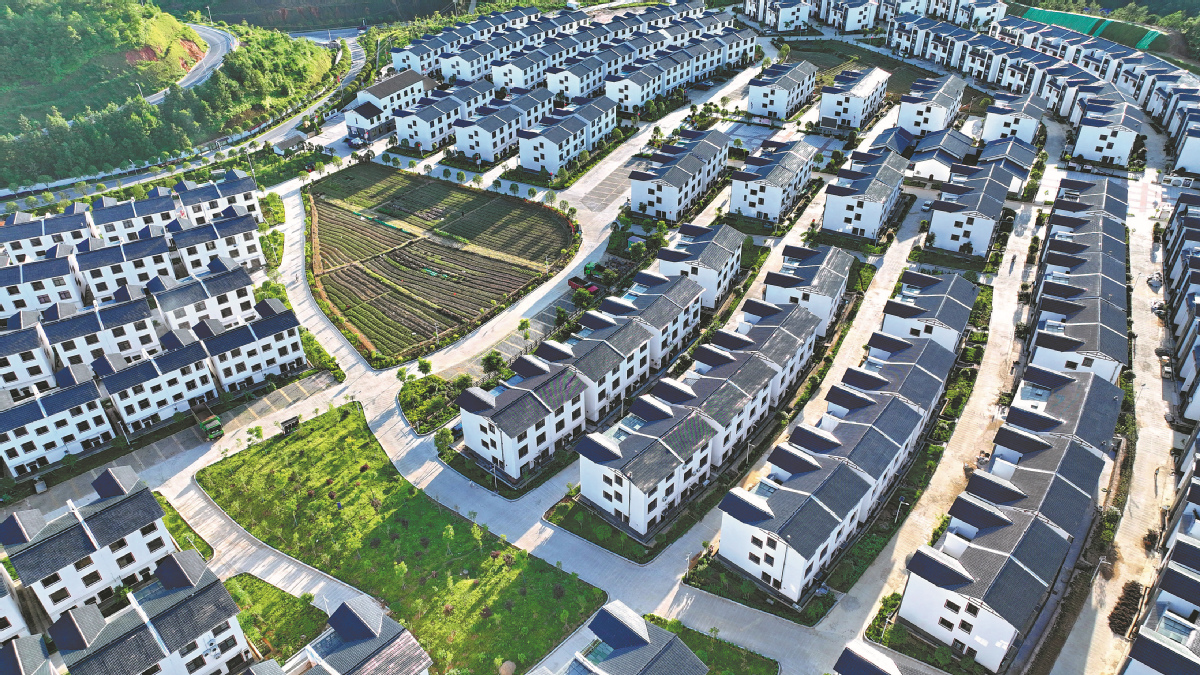
An aerial view of Qixin village fields (left) and Zikeng village houses (right) in Huichang county, Jiangxi province. [CHINA DAILY]
Rao Yuxiao never expected that returning to the countryside would increase his income several fold.
In 2012, after graduating from college, Rao left Huichang county in Jiangxi province and moved to Fujian province. He quickly found a job as a planner for an advertising company in Xiamen.
"I worked from nine to six every workday. At that time, the term '996' (9 am to 9 pm, six days a week) didn't exist yet, but the work pressure was still significant," said the 34-year-old.
The turning point came in 2015. That year, Rao married and returned to his hometown of Huichang "for a stable and cozy life".
By then, rural areas had started providing subsidies for young people returning to their hometowns to farm.
Nowadays, there are more diverse policies supporting young people who are returning to the countryside, he said. For example, the county strongly supports large-scale farming, and provides agricultural technology guidance and end-to-end agrarian services, including drone spraying and harvesting, all of which can be done on a single mobile platform.
Previously, Rao made around 150,000 yuan ($21,100) a year working in Fujian. "Now, I can earn hundreds of thousands more. This is beyond what I had imagined," he said.
The policies are part of the rural reform initiatives implemented in Huichang in 2022, a year after nearly 100 million rural poor in China had been lifted out of abject poverty.
At the end of February 2021, President Xi Jinping announced China had secured a "complete victory" in its fight against poverty. All 832 counties designated by the government as poverty-stricken in 2013 have shaken off their poverty labels. China has achieved the poverty reduction goals of the United Nations' 2030 Agenda for Sustainable Development 10 years ahead of schedule.
Many of China's rural areas have also become models for poverty alleviation in developing countries, but success also brings greater responsibilities.
As a result, the focus of China's rural work has shifted to comprehensively promoting rural vitalization.
In 2021, at the Central Rural Work Conference, Xi emphasized that after achieving victory in poverty alleviation, the focus should shift to comprehensively advancing rural vitalization, marking a historic shift in the focus of rural development. Importantly, it is crucial to maintain the achievements of poverty alleviation and effectively connect them with rural vitalization to ensure continued prosperity in rural areas, he added.
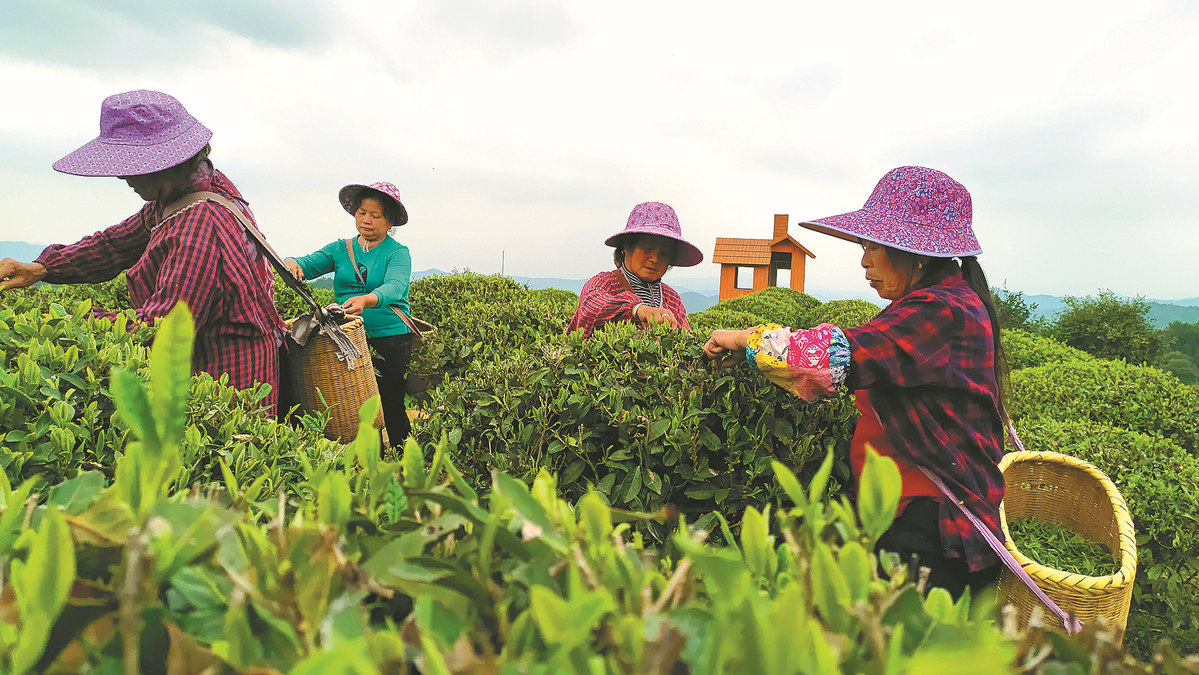
Workers pick tea leaves at a mountain plantation in Huichang on March 30. [LIU ZHAOCHUN/CHINA DAILY]
Practical solutions
This brought together hundreds of local governments to address a practical problem: What could villages do to achieve this?
Pan Jincheng, the secretary of the Communist Party of China Huichang county committee, formed a team to research rural vitalization.
After several months of research and visits to rural households, they identified that a number of assets, such as farmland and factories in many villages, were lying idle.
"China's efforts to alleviate poverty have successfully eliminated absolute poverty and addressed the deficiencies in infrastructure and public services in villages, resulting in the accumulation of substantial assets for the village collectives. Unfortunately, many of these assets had not been fully utilized, and even been neglected," Pan said.
During the poverty alleviation period, local governments and social organizations invested significantly in projects such as greenhouses, affordable housing, photovoltaic facilities, and farmland water conservancy facilities.
These assets had accumulated over the years of poverty alleviation achievements and could also form the material foundation for the comprehensive vitalization of rural areas, Pan said.
"Therefore, we decided to revitalize these assets, find a good operational model, and support rural vitalization," he said.
The first objective was to put the idle lands into use by village cooperatives. The cooperatives began by signing custody and transfer agreements with rural households that held idle land.
The land was then leased as consolidated plots to prominent businesses and large farming households, which collectively organized planting. Landowners can earn a share of the profits under the agreements.
Rao is one such large household. Apart from cultivating rice on the leased farmland, he also engages in rice breeding. He stays busy tending to his crops throughout the year.
Currently, village cooperatives and farmers in the county have signed custody agreements for over 60,000 mu (4,000 hectares).
To effectively manage village assets, Huichang formed the Zhenxing Agricultural Industry Group. The company is driven by county-wide coordination, leadership from State-owned enterprises, and a "five-party operational system" to promote rural vitalization.
"The five-party operational system mainly involves cooperating and coordinating five aspects. The Zhenxing group is one of the parties, with subsidiary companies set up in each town, where village cooperatives participate as shareholders. Subsequently, leading enterprises can be brought in, and farmers receive dividends by investing resources such as land or getting jobs from local companies," Pan said.
"This not only enriches rural areas but also unites them, enhancing their resilience in the market. Most importantly, it enables large-scale agricultural production and coordinated farming-related services," he added.
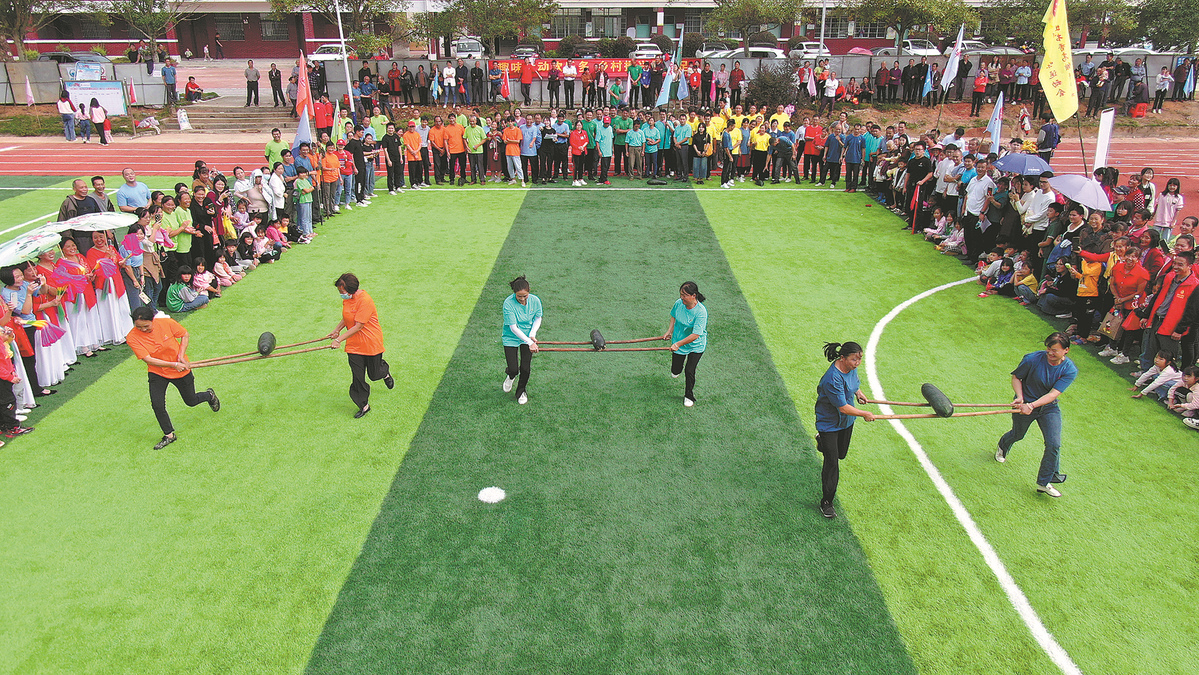
Villagers participate in a sports event featuring fun activities in Huichang on Oct 14. [LIU ZHAOCHUN/CHINA DAILY]
Collectives in action
Qixin village in Mazhou town, Huichang, is one good example.
Many of its residents had moved to other cities, which had left over 85 percent of the town's farmland uncultivated, said Ou Ling, the deputy town chief.
Over the past two years, the town encouraged farmers to entrust their land to the village collective economic cooperatives.
The town also established a seedling production center and a comprehensive mechanized agricultural service center to maximize production efficiency of the land.
The seedling production workshop integrates sowing operations, post-sowing management, and farming-related services. Up to 1,000 mu of seedlings can be sowed per day.
Meanwhile, the mechanized agricultural service center reduces production costs through implementing large-scale operations.
"In 2021, the cost of plowing per mu was 160 yuan. Now, it's only 110 yuan. Machine planting costs were 100 yuan per mu last year, but now they are down to 80 yuan. Harvesting costs have also decreased by nearly 20 yuan per mu. According to our calculations, through comprehensive mechanized agricultural services, we can save 90 yuan per mu from planting to harvesting compared with last year," Ou said.
"Our town's total area of early, middle, and late rice cultivation is over 30,000 mu. As a result, the agricultural costs in our town have been reduced by over 2 million yuan," he added.
Farmers are able to conveniently place orders through an intelligent platform to access centralized seedling cultivation, seed planting, land management, and centralized procurement of pesticides and fertilizers.
"Just like urban residents can order a taxi using their smartphones, we also have 'Didi farm machinery'," he said.
Liu Jianqing from Xiabao village said, "My sons and daughters are all working outside, and every year during the busy farming season, I used to spend money hiring assistance on the platform. Now, my fields are all managed properly, and my son can order land cultivation services on the platform, even while working in another province."
Since the introduction of the online service, Liu said he had assumed the role of a "hands-off manager".
Pan said that due to the long-term migration of rural populations to urban areas to work in industrial jobs, there is a labor shortage in rural areas.
"Additionally, rural aging is a serious social issue, with most workers being middle-aged or older, especially those aged 50 and above. Moreover, the efficiency of agricultural production remains low, creating a growing need for agricultural services (in rural areas)," Pan said.
"So we need a modern, centralized system and to utilize scattered farmland to improve agricultural mechanization services, like we have done in Huichang. This will allow even the elderly to use smartphones to order agricultural services while increasing farmers' incomes, " he added.
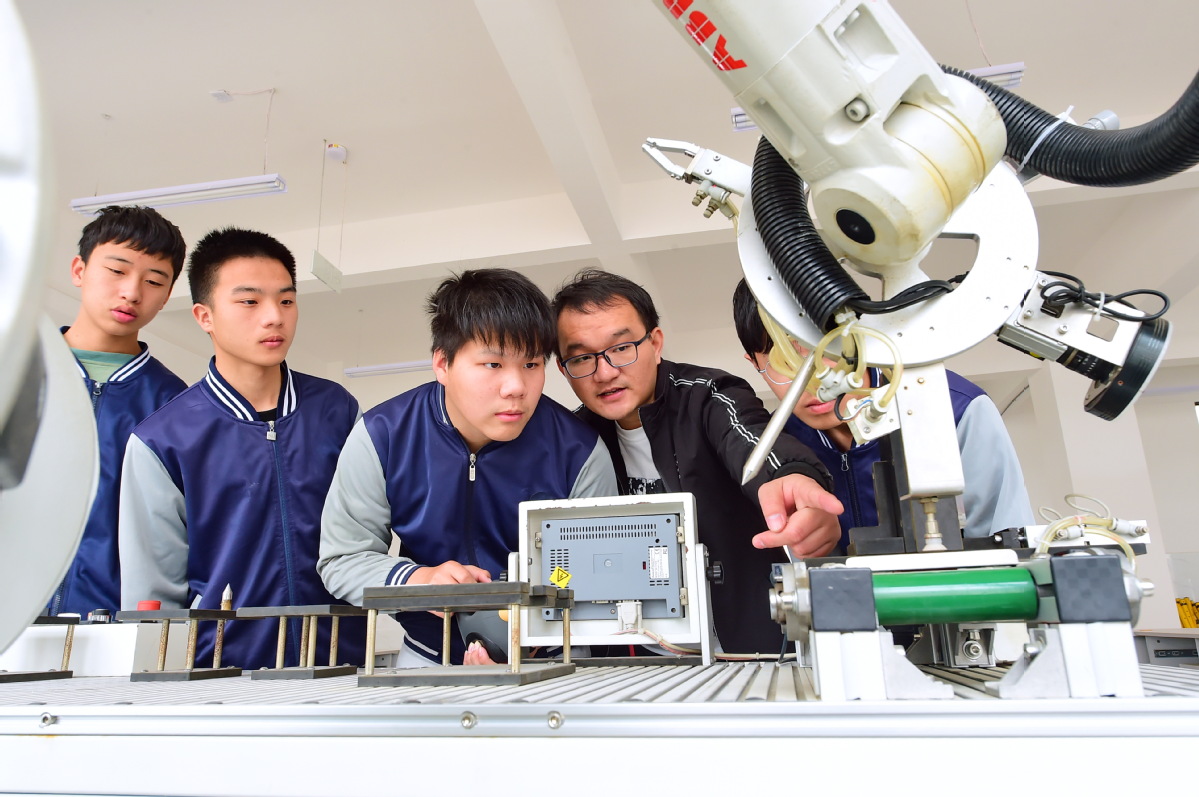
Students from a local vocational school learn about robot programming at the intelligent manufacturing training center in Huichang, in February last year. [ZHU HAIPENG/FOR CHINA DAILY]
Modern methods
The 19th National Congress of the CPC proposed the construction of modern agricultural industrial systems, production systems, and operation systems, as well as the improvement of agricultural support systems.
The aim is to develop various forms of moderate-scale operations, cultivate new agricultural operators, improve agricultural social service systems, and achieve organic integration between small-scale farmers and modern agricultural development.
"Essentially, we are trying to connect small-scale farmers with modern production (methods) as much as possible. We aim to build a modern agricultural industrial, product, and operations systems," Pan said.
Wang Xiulin, former chairman of the Zhenxing Group, said their farming-related projects in Mazhou town are operated and developed by a subsidiary of the company.
"Village collective economic cooperatives manage land leasing, while other leading enterprises in the town can join to absorb employment and organize production, boosting farmers' income. Farmers can receive dividends and benefits by leasing their land while providing labor and remuneration for the town's enterprises," he said.
"This is the concrete manifestation of the five-party operational system," he added.
In addition to traditional agriculture, Huichang has also utilized its ecological and cultural advantages, as well as its location, to promote the integrated development of agriculture, culture, and tourism.
This transformation aims to convert green mountains and clear waters into "mountains of gold and silver", and effectively utilize ecological advantages as developmental strengths.
For instance, in Zikeng village, Bai'e township, a company was established to take advantage of its proximity to Hejun Education Town and Hejun Vocational College.
The company is turning idle farmhouses into homestays, providing labor services for Hejun town, and offering eco-friendly agricultural products, which have all helped increase collective annual income from 300,000 yuan to 1.2 million yuan.
Meanwhile, Dongtou town is leveraging the unique cultural and ecological advantages of the She ethnic group to develop rural tourism and holiday resorts.
The development includes study tours, team-building activities, She-themed homestays, ethnic cuisine, performance experiences, and agricultural products. Dongtou is expected to achieve annual tourism income of over 5 million yuan.
Apart from agriculture, the industrial sector has also seen significant development under the new system in Huichang.
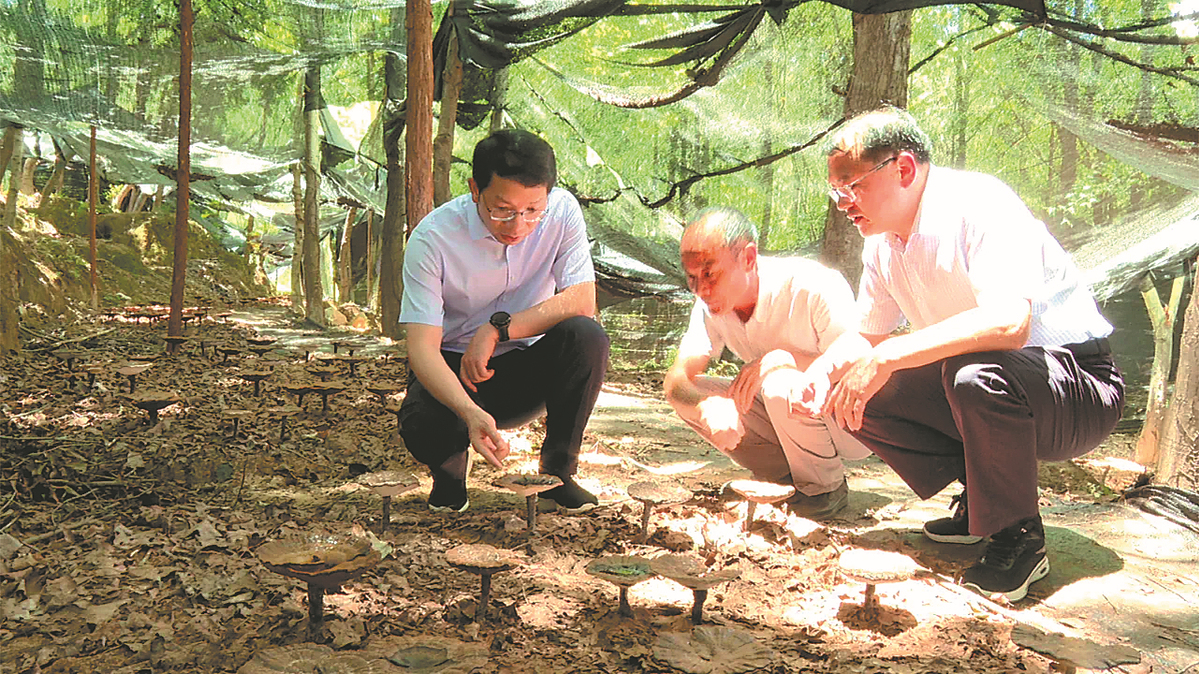
Pan Jincheng (left), the secretary of the CPC Huichang county committee, learns about the development of under-forest economy in the county's Zhongcun village on July 4. [CHINA DAILY]
Expansion underway
In 2017, Xijiang town established a poverty alleviation workshop with six standard factories. By 2022, the workshop was managed by a subsidiary of the Zhenxing Group.
The industrial base now hosts 14 pollution-free and labor-intensive enterprises, including garment and footwear manufacturers, employing approximately 2,000 people.
Yang Meitao, in her late 30s, works at a shoe factory in the workshop. She hails from Qiangong, a nearby village, and her husband works outside the province. She started working at the factory in May 2023.
"Working here is quite good. First, it's close to my home, making it convenient for me to care for elderly relatives and my children. Second, it provides a stable income for us women without jobs. I can earn over 5,000 yuan a month, which I'm very satisfied with," Yang said.
Zhong Fangfang, a manager at the shoe factory, said that the factory mainly produces shoes for sportswear brand Tebu.
"The factory employs over 300 workers, mostly villagers from the surrounding areas of Xijiang town, with over 90 percent of the employees being women."
Zhong said that the average wage in the factory is above 3,500 yuan, and can reach 10,000 yuan.
Zeng Xianghua, the director of the People's Armed Forces Department in Xijiang town, said that the current operational model provides employment opportunities, especially for "invisible" unemployed people who need to care for the elderly and their children.
Expansion of the industrial base is underway, which will allow for the accommodation of nearly 40 small and medium-sized enterprises and create work opportunities for 5,000 people.
Last year, Huichang registered and operated the "Huichang Duhao" brand, working with local companies to promote the commercialization of Huichang products, such as navel oranges, pomelos, rice noodles, and dried tofu.
So far, the county has developed 180 products across 10 categories.